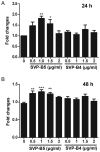SVP-B5 peptide from Buthus martensii Karsch scorpion venom exerts hyperproliferative effects on irradiated hematopoietic cells
- PMID: 29201218
- PMCID: PMC5704312
- DOI: 10.3892/etm.2017.5152
SVP-B5 peptide from Buthus martensii Karsch scorpion venom exerts hyperproliferative effects on irradiated hematopoietic cells
Abstract
Previous studies have demonstrated the radioprotective efficacy of scorpion venom peptide, fraction II (SVPII) from the venom of Buthus martensii Karsch. In the present study, the SVP-B5 polypeptide, which is one of the active components of SVPII, was purified using a two-step chromatographic process. SVP-B5 significantly promoted the proliferation of irradiated M-NFS-60 mouse-derived myelocytic leukemia cells. In addition, SVP-B5 effectively and persistently promoted hematopoietic recovery and expansion of hematopoietic cells after irradiation as demonstrated by cobblestone area forming cell and long-term bone marrow culture assays. Treatment of M-NFS-60 cells with SVP-B5 upregulated the expression of interleukin 3 receptor and activated the Janus kinase-2/signal transducer and activator of transcription 5 signaling pathway. In conclusion, the present study demonstrated that SVP-B5 has growth factor-like properties and may be used as a therapeutic modality in the recovery of severe myelosuppression, which is a common side effect of radiotherapy.
Keywords: hematopoiesis; interleukin-3; irradiation; polypeptides; scorpion venom.
Figures





Similar articles
-
Scorpion venom peptide SPVII promotes irradiated cells proliferation and increases the expression of the IL-3 receptor.Cell Biosci. 2013 Jul 8;3(1):28. doi: 10.1186/2045-3701-3-28. Cell Biosci. 2013. PMID: 23835458 Free PMC article.
-
Effects of Scorpion venom peptide B5 on hematopoietic recovery in irradiated mice and the primary mechanisms.Sci Rep. 2015 Oct 20;5:15363. doi: 10.1038/srep15363. Sci Rep. 2015. PMID: 26482294 Free PMC article.
-
Scorpion venom polypeptide accelerate irradiated hematopoietic cells proliferation.Pathophysiology. 2009 Oct;16(4):253-8. doi: 10.1016/j.pathophys.2009.02.012. Epub 2009 Mar 13. Pathophysiology. 2009. PMID: 19285842
-
Peptides with therapeutic potential in the venom of the scorpion Buthus martensii Karsch.Peptides. 2019 May;115:43-50. doi: 10.1016/j.peptides.2019.02.009. Epub 2019 Mar 8. Peptides. 2019. PMID: 30858089 Review.
-
The Significant Therapeutic Effects of Chinese Scorpion: Modern Scientific Exploration of Ion Channels.Pharmaceuticals (Basel). 2024 Dec 22;17(12):1735. doi: 10.3390/ph17121735. Pharmaceuticals (Basel). 2024. PMID: 39770577 Free PMC article. Review.
Cited by
-
Retracted Article: Structural characterization and anti-inflammatory potency of Mesobuthus martensii Karsch oligopeptides in lipopolysaccharide (LPS)-induced RAW264.7 macrophages.RSC Adv. 2019 Aug 9;9(43):24822-24832. doi: 10.1039/c9ra01623f. eCollection 2019 Aug 8. RSC Adv. 2019. Retraction in: RSC Adv. 2022 Apr 27;12(19):11620. doi: 10.1039/d2ra90035a. PMID: 35528642 Free PMC article. Retracted.
-
Scorpion Venom as a Source of Antimicrobial Peptides: Overview of Biomolecule Separation, Analysis and Characterization Methods.Antibiotics (Basel). 2023 Aug 29;12(9):1380. doi: 10.3390/antibiotics12091380. Antibiotics (Basel). 2023. PMID: 37760677 Free PMC article. Review.
References
LinkOut - more resources
Full Text Sources
Other Literature Sources
